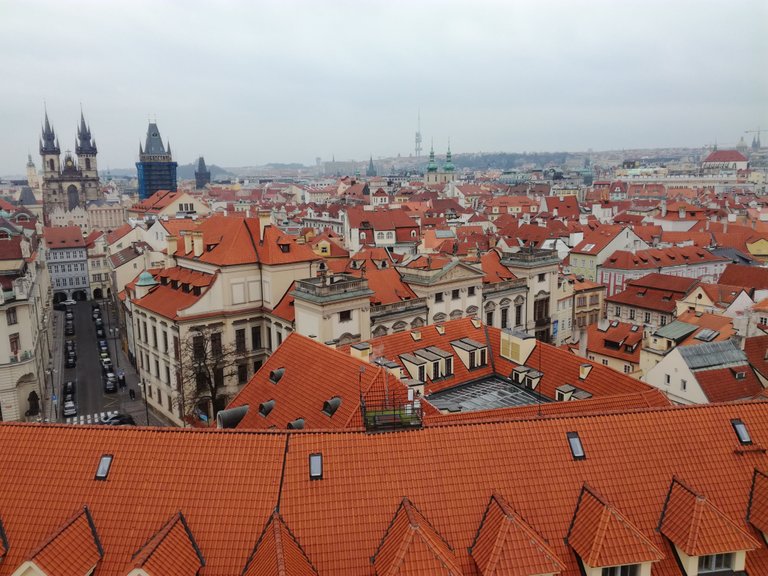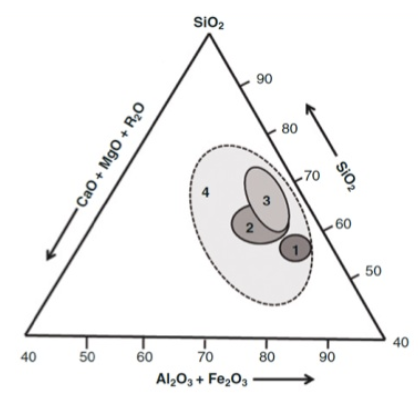This is my entry to the third #sciencepic picture challenge hosted by @mcw. I appreciate your effort and I am happy to contribute again to the current challenging - because quite non-specific - topic of 'red'.
Dies ist mein Eintrag zu der dritten #sciencepic Bilder-Challenge von @mcw. Ich schätze seine Mühen und hoffe, dass es diese Aktionen auch künftig immer wieder geben wird. Die diesmalige Vorgabe 'Rot' empfand ich als eine kleine Herausforderung, da es mir schwer viel mich auf ein Thema festzulegen. - Ich hoffe es gefällt!
 The mostly red rooftops of Prague. / Die überweigend roten Dächer von Prag.
The mostly red rooftops of Prague. / Die überweigend roten Dächer von Prag.With my entry I would like to briefly address the natural red color of roofing tiles and how they are manufactured. Let's start with the raw materials used for such ceramics:
- Fluxes like felspar, a silicate mineral
- Temper such as quartz, shells or ores
- non-plastic Metal Oxides, like CaO, from burnt lime
The production of certain types of ceramics very much depends on desired product properties. Hence the mixing ratios and the qualties of the used basic constituents has to be adjusted. The raw materials are wet-mixed, shaped, dried and finally fired.
Fluxes have the purpose of lowering the melting temperature and thus fill the pores between individual grains during the firing process. They ensure a homogeneous well-compacted product. This is also the reason for the fact, that in porcelain, a form of ceramic, the proportion of flux is notably high.
Roof tiles are building ceramics and thus belong to the so-called earthenwares. Due to their production and the raw materials used, they are non-translucent, porous, ceramic goods, which are referred to as shards.
The colour of the shardes can be procreated by glazes. This is a thin layer of selected minerals, which are burned to the surface. If this is not done, the color results from the metal oxides used for the basic matrix and the applied firing technique. Since iron is the most common metal, the red color of roof tiles is due to the presence of iron oxides.

Multi Ternary phase diagram of non-refractory clay/silicate ceramics:
1: Tiles and terracotta, 2: bricks, 3: masonry, 4: coarse pottery
Multiternäres Phasendiagramm nicht feuerfester Ton-/Silikatkeramik:
1: Fliesen und Terrakotta, 2: Steine, 3: Ausmauerungen, 4: Grobkeramiken
Source: Dr.-Ing. Guido Falk
Mit meinem Eintrag möchte ich kurz und bündig auf die natürliche rote Farbe von Dachziegeln und deren Herstellung eingehen. Grund-sätzlich zählen Dachziegel zu den keramischen Produkten, welche aus folgenden Komponenten aufgebaut sind:
- Flussmitteln wie Feldspat, einem silikatischen Mineral
- Magerungsmitteln wie Quarz, Muscheln oder Erze
- nicht-plastische Oxide, wie gebrannter Kalk CaO
Zur Herstellung von keramischen Produkten werden je nach gewünschtem Produkt unterschiedliche Mischungsverhältnisse der Grundbestandteile und natürlich auch Rohstoffe unterschiedlicher Güte nass vermengt, geformt, getrocknet und schließlich gebrannt.
Flussmittel haben dabei den Zweck die Schmelztemperatur zu erniedrigen, um beim Brennvorgang möglichst gut die Poren zwischen den einzelnen Körner auszufüllen. Sie sorgen also für ein homogenes gut verdichtetes Produkt. Das ist auch der Grund dafür, dass im durch-scheinenden Porzellan, einer Form von Keramik, der Anteil an Fluss-mitteln besonders hoch ist.
Dachziegeln sind Baukeramiken und zählen damit neben 'Steingut' und 'Tonwaren' zum sogennanten Irdengut. Auf Grund ihrer Herstellung und der verwendeten Rohstoffe ergeben sich nicht-durchscheinende, poröse, keramische Güter, welche als Scherben bezeichnet werden.
Die Farbe der Scherben kann durch Glasuren beeinflusst werden. Dabei handelt es sich um eine dünne Schicht ausgewählter Minerale, welche an der Oberfläche eingebrannt werden. Wird dies nicht gemacht resultiert die Farbe aus den für die Matrix verwendeten Metalloxiden und der Brenntechnik. Da Eisen das häufigste Metall ist, ist die rote Färbung von Dachziegeln auf Eisenoxide zurückzuführen.
mountain.phil28
References:
- G. Falk, Handout Keramik-Grundlagen Universität Saarland, 2015
- A Wikipedia Article on Dachziegel / Roofing tiles
- A Wikipedia Article on the Classification of ceramic materials
This is a test comment, notify @kryzsec on discord if there are any errors please.
Being A SteemStem Member
Also rot wegen den verwendeten Materialien ;)
Der Großteil der verwendeten Rohstoffe hat kaum eine nennenswerte Farbe, die enthaltenen Eisenoxide im Endprodukt machen es aus. Eisen is relativ ubiquitär vorhanden und wird beim Brennprozess in seine Oxide überführt, diese haben ein kräftiges Rot. :)
Omg you know dutch )0( (sorry for the side track 😂)
Actually i initially thought the red color are additives
Rally nice to learn some mineral chemistry and minerals are always so facinating !!!!
That's German... xD But close guess. 🤣
Thank you very much for the nice comment!
nice post